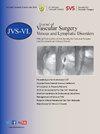Varicose vein surgery after acute isolated superficial vein thrombosis in daily practice: INSIGHTS-SVT study
IF 2.8
2区 医学
Q2 PERIPHERAL VASCULAR DISEASE
Journal of vascular surgery. Venous and lymphatic disorders
Pub Date : 2024-05-29
DOI:10.1016/j.jvsv.2024.101917
引用次数: 0
Abstract
Objective
The aim of this study was to assess the utilization of surgical interventions in patients diagnosed with superficial vein thrombosis (SVT) and its potential association with the occurrence of venous thromboembolism (VTE) and bleeding events.
Methods
INSIGHTS-SVT, a prospective, non-interventional, multicenter study in Germany, investigated the management and outcomes of patients with acute SVT who received conservative and/or invasive treatments at the discretion of the treating physician.
Results
Among the 872 patients with 12-month data, 657 had medical therapy only, and 215 patients underwent vascular surgery (70 within 3 months of SVT diagnosis, 136 between months 4 and 12, and nine had an intervention in both periods). The most commonly performed procedures included endovenous thermal ablation, ligation of the saphenofemoral or saphenopopliteal junction, and vein stripping. The primary outcome of symptomatic VTE was observed in 5.8% of conservatively treated patients and 6.3% of those who underwent surgical intervention. Additionally, the secondary outcome of recurrent or extended SVT was documented in 4.7% of conservatively treated patients and 5.3% of invasively treated patients. Bleeding events occurred in 1.4% of conservatively treated patients and 2.1% of surgically treated patients. These differences were statistically not significant. Furthermore, our analysis indicated a potential protective effect associated with surgical treatments, such as ligation of the saphenofemoral or saphenopopliteal junction, stripping and endovenous thermal ablation, concerning the endpoint of VTE for patients when applied after 3 months from the index SVT event.
Conclusions
In line with previous research, our study suggests that surgical interventions are not frequently employed in the management of SVT, although they may be warranted in select cases. Nevertheless, additional research is essential to gain a deeper understanding of the indications, criteria, and benefit of surgical interventions in the treatment of SVT.
日常实践中急性孤立浅静脉血栓形成后的静脉曲张手术:INSIGHTS-SVT 研究。
研究目的本研究旨在评估被诊断为浅静脉血栓形成(SVT)的患者使用外科干预的情况及其与静脉血栓栓塞(VTE)和出血事件发生的潜在关联:INSIGHTS-SVT是一项在德国进行的前瞻性、非干预性、多中心研究,它调查了由主治医生决定接受保守和/或侵入性治疗的急性SVT患者的治疗方法和结果:在 872 名获得 12 个月数据的患者中,657 名仅接受了药物治疗,215 名接受了血管外科手术(70 名在 SVT 诊断后三个月内接受,136 名在第 4 个月至第 12 个月之间接受,9 名在这两个时期都接受了介入治疗)。最常见的手术包括静脉腔内热消融术(EVTA)、隐股动脉或隐腘动脉交界处(SFJ/SPJ)结扎术和静脉剥脱术。在接受保守治疗的患者中,5.8% 出现了症状性 VTE,而在接受手术干预的患者中,6.3% 出现了症状性 VTE。此外,4.7%的保守治疗患者和 5.3%的侵入治疗患者出现了 SVT 复发或扩展的次要结果。1.4%的保守治疗患者和2.1%的手术治疗患者发生了出血事件。这些差异在统计学上并不显著。此外,我们的分析表明,手术治疗(如 SFJ/SPJ 结扎、剥离和 EVTA)在发生 SVT 事件 3 个月后对患者的 VTE 终点具有潜在的保护作用:与之前的研究一致,我们的研究表明,手术干预在 SVT 的治疗中并不常用,但在某些情况下可能是有必要的。尽管如此,要想更深入地了解手术干预治疗 SVT 的适应症、标准和益处,还必须开展更多的研究。
本文章由计算机程序翻译,如有差异,请以英文原文为准。
求助全文
约1分钟内获得全文
求助全文
来源期刊

Journal of vascular surgery. Venous and lymphatic disorders
SURGERYPERIPHERAL VASCULAR DISEASE&n-PERIPHERAL VASCULAR DISEASE
CiteScore
6.30
自引率
18.80%
发文量
328
审稿时长
71 days
期刊介绍:
Journal of Vascular Surgery: Venous and Lymphatic Disorders is one of a series of specialist journals launched by the Journal of Vascular Surgery. It aims to be the premier international Journal of medical, endovascular and surgical management of venous and lymphatic disorders. It publishes high quality clinical, research, case reports, techniques, and practice manuscripts related to all aspects of venous and lymphatic disorders, including malformations and wound care, with an emphasis on the practicing clinician. The journal seeks to provide novel and timely information to vascular surgeons, interventionalists, phlebologists, wound care specialists, and allied health professionals who treat patients presenting with vascular and lymphatic disorders. As the official publication of The Society for Vascular Surgery and the American Venous Forum, the Journal will publish, after peer review, selected papers presented at the annual meeting of these organizations and affiliated vascular societies, as well as original articles from members and non-members.
 求助内容:
求助内容: 应助结果提醒方式:
应助结果提醒方式:


